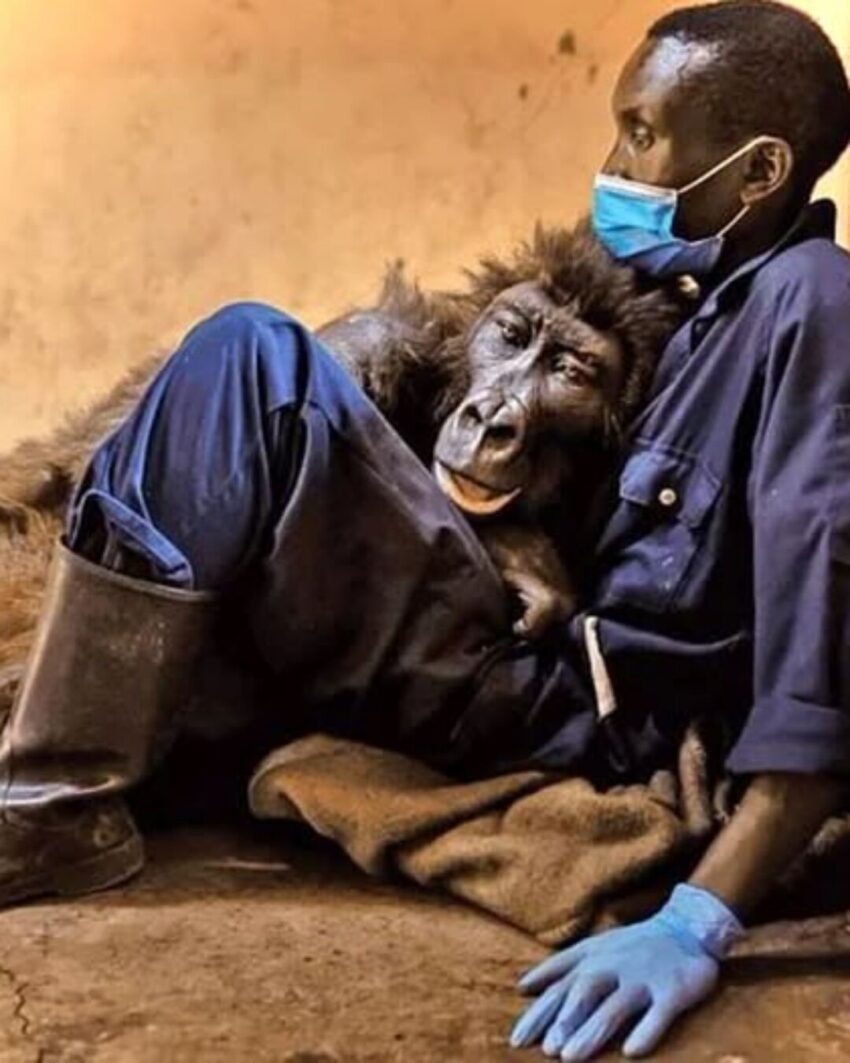In the soft light of dawn, deep within the forest sanctuary, a quiet stillness fell over the camp. The young gorilla — tiny, fragile, and weak — rested in her caretaker’s arms. Her breathing was shallow now, her eyes half-closed, but she still clung to him with the same trust she had shown on the night they first met.
Her name was Ndakasi.
Years earlier, she had been found clinging to her mother’s lifeless body after poachers raided Virunga National Park in the Congo. She was only a few months old — too young to survive on her own, too innocent to understand why her world had been shattered. When rangers discovered her, she refused to let go of her mother’s body, her tiny hands gripping the fur with heartbreaking determination.
That’s when Andre Bauma, a ranger at the park’s gorilla orphanage, arrived. Gently, he lifted her into his arms. “I told her, ‘You are safe now,’” Andre would later recall. “From that moment, I never left her.”
Through storms, sickness, and sleepless nights, Andre kept that promise.

He held Ndakasi against his chest every night in those early months, keeping her warm and calm when she woke screaming for her mother. He fed her by bottle, brushed her fur, and sang to her softly when the thunder frightened her. “She was like a child to me,” he said. “She trusted me with everything.”
And in time, that trust blossomed into something extraordinary — a bond that blurred the lines between species.
Ndakasi grew stronger. Her wide eyes sparkled with mischief. She learned to play, to climb, to love. The rangers at Virunga often joked that she was “half gorilla, half human,” because she adored mimicking Andre’s expressions — his smiles, his frowns, even his laughter.
In one viral photograph that touched millions, Ndakasi and another gorilla named Ndeze leaned against Andre, both posing with cheeky grins. It became a symbol of resilience and the deep connection between humans and wildlife — a glimpse of peace in a world too often torn by cruelty.
But behind that smile was a story of survival paid for in heartbreak. The trauma of losing her family had left lasting scars. Though Ndakasi lived safely within the sanctuary for years, her body remained fragile. Her heart was never as strong as her spirit.
Then, one day, the caretakers noticed she wasn’t eating. Her energy faded. Despite every effort — medicine, rest, gentle care — her condition worsened. Andre refused to leave her side.
And so it was, on that final day, that the two who had found each other in grief came full circle in love.
Andre sat with her, as he had so many nights before. Ndakasi rested her head against his chest, just as she had when she was an infant. She wrapped her arm around him weakly — a final, instinctive embrace. Her breathing slowed, her body softening into his.
There were no words. Just the sound of a caretaker’s quiet sobs and the rustle of leaves outside as the forest seemed to hold its breath.
When she passed, Andre didn’t move for a long time. He just held her — as if, by doing so, he could keep her spirit close for one moment more.
“She died in my arms, peaceful,” he said later, tears in his eyes. “Like the first night I held her.”
The photo taken that day — of Andre holding Ndakasi in her final moments — broke hearts across the world. Not because it showed loss, but because it revealed love in its purest form: unconditional, wordless, and eternal.
Andre never saw himself as a hero. “I only did what any human should do,” he said. “She needed love, and I gave her that. She gave me so much more in return.”
Today, her memory lives on at Virunga — not as a story of tragedy, but as a testament to compassion. Every rescued gorilla cared for at the park carries her legacy. Every ranger who risks their life to protect wildlife does so with her story in their heart.
In a world where greed and violence often win, Ndakasi and Andre showed something greater: that love — even between species — has the power to heal, to inspire, and to remind us of our shared humanity.
She came into this world clinging to loss.
She left it held in love.
